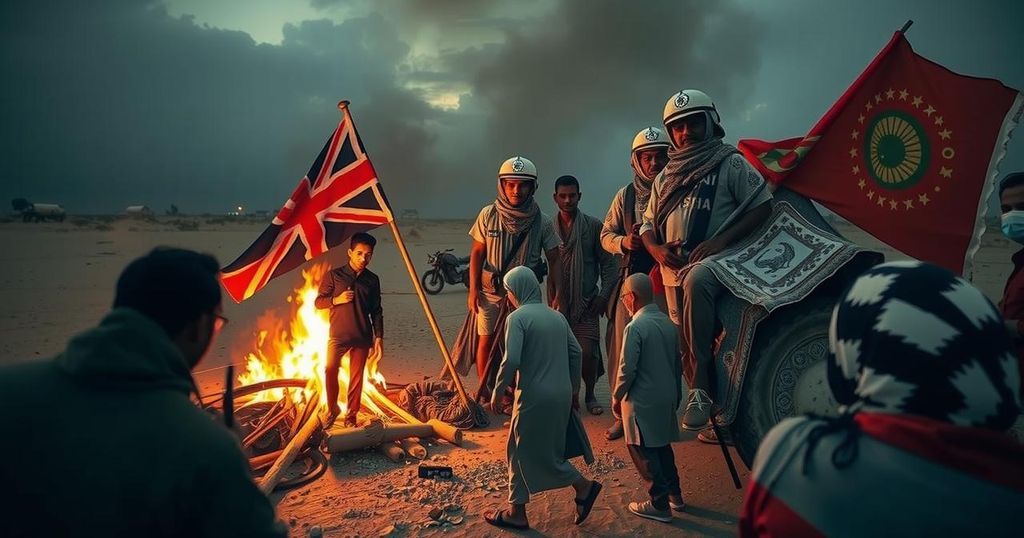This article recounts the history of Somalia from the pre-colonial period through to its independence in 1960, emphasizing the role of religious and clan dynamics in shaping the region’s response to colonial rule. Led by Maxamed Cabdulle Xasan, the dervishes confronted British forces, highlighting the complexities of Somali identity. The unification of British and Italian Somaliland into the Somali Republic initiated new challenges, including internal governance and regional conflicts, ultimately shaping the contemporary sociopolitical landscape of Somalia, especially during the militaristic era under Maxamed Siad Barre.
Prior to the partition of Africa, the British Somaliland protectorate faced significant unrest due to a religious insurrection led by Maxamed Cabdulle Xasan, commonly referred to as the Mad Mullah by British authorities. This respected Somali sheikh, part of the Ogaadeen clan, was deeply influenced by the Ṣaliḥiyyah religious order, and gained popularity for his scholarly and pious attributes. Initial cooperation with colonial rulers faded in 1899 as he clashed with Christian missionaries and British officials, setting off a wider Somali revolt influenced by contemporary anti-colonial sentiments, notably those inspired by other historical figures like the Sudanese Mahdi. Though Maxamed refrained from claiming the Mahdi title, he adopted the honorific sayyid and mobilized a following known as the dervishes, fostering an atmosphere of national solidarity against colonial powers. As arms became accessible through coastal ports, the dervishes opposed British, Italian, and Ethiopian campaigns between 1900 and 1904, effectively utilizing guerrilla strategies that challenged the British military’s prowess. Following a withdrawal of British forces in 1910, which left a power vacuum, Sayyid Maxamed appeared to have triumphed. However, by 1920, a concerted military effort involving air and naval forces ultimately dismantled his stronghold at Taleex. Following this conflict, the British recommenced administrative control, while in Italian Somaliland, governance saw a shift under fascist influence as political integration advanced. World War II prompted another realignment of control, with Somalia later achieving independence. The unification of British Somaliland and Italian Somalia on July 1, 1960, established the Somali Republic. The newly independent state grappled with the legacies of colonial division, prompting internal strife informed by clan loyalties. Internationally, Somalia pursued unification objectives for communities in adjacent regions, leading to tensions particularly with Kenya and Ethiopia. The military coup of 1969 placed Maxamed Siad Barre in power, marking the beginning of his authoritarian regime that embraced “Scientific Socialism.” Barre’s government sought to transform Somali society through literacy and economic initiatives, while the state also engaged in a conflict regarding the Ogaden region with Ethiopia, fueled by the backing of the Soviet Union during the Cold War era. Subsequent military conflicts led to socioeconomic consequences, including a significant influx of Somali refugees due to military actions in Ethiopia, indicating the ongoing regional instability and the complexities of Somali national identity.
The article chronicles the tumultuous history of Somalia from the pre-partition era through independence, focusing on the parliamentary struggles, colonial challenges, and military governance under Maxamed Siad Barre. The narrative highlights how religious and clan identities shaped the social and political landscape of the territory. Critical events such as the dervish movements against colonial rule and the eventual establishment of the Somali Republic delineate the struggles for autonomy and national unity amid external pressures from colonial powers and neighboring states. The complex legacy of these dynamics is foundational to understanding contemporary Somalia’s sociopolitical intricacies, including the lingering effects of colonialism and the challenges of establishing governance by a diverse populace.
In conclusion, the historical trajectory of Somalia illustrates a narrative shaped by colonial struggles, religious fervor, and clan politics. The legacy of Maxamed Cabdulle Xasan’s rebellion provided the impetus for enduring anti-colonial sentiments that harmonized with the eventual pursuit of independence. The unification of formerly divided territories into the Somali Republic marked a significant milestone, yet the resultant governmental challenges reveal the difficulties inherent in reconciling historical grievances and diverse identities within a unified national framework. Moreover, the military regimes and external socio-political entanglements have indelibly impacted Somalia, continuing to influence its current realities.
Original Source: www.britannica.com






